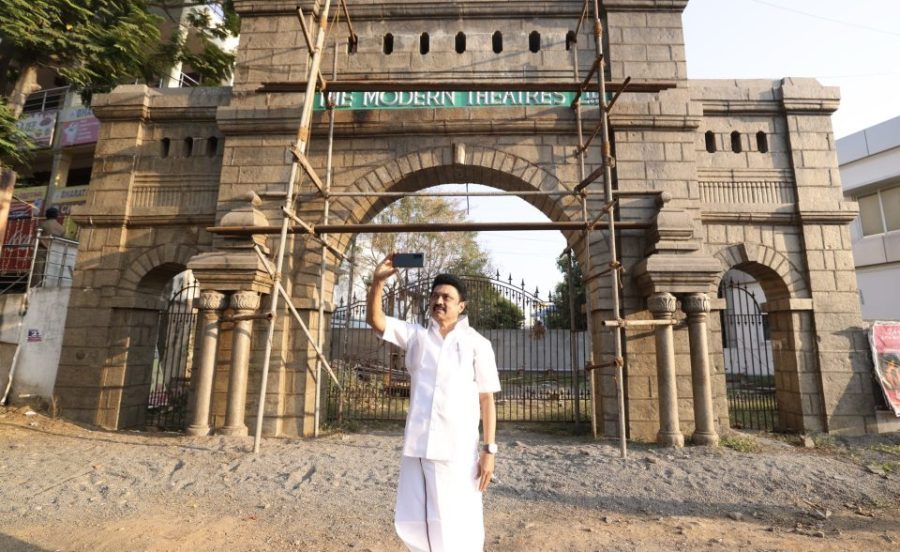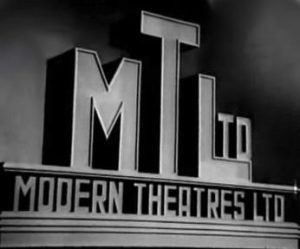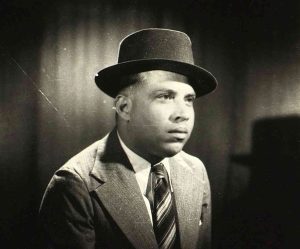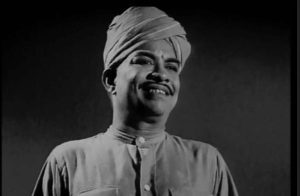
Salem's Modern Theatres is back in the news, and so is actor Kali Ratnam
The film production firm had future Tamil Nadu CMs on its payroll; it also had one of Tamil cinema's most talented comedians on board - Kali N Ratnam

On a visit to Salem district on February 15, the Tamil Nadu Chief Minister MK Stalin made a brief stop at the gates of Modern Theatres, a film production studio that had in the past seen glorious days and dominated the Tamil film industry. The CM took selfies in front of the gates, which still carried the film production company’s name, and his pictures went viral on social media.
Stalin had a solid reason to take a selfie against the backdrop of this defunct film production studio, which is now being converted into a residential property. After all, it was here that his father, the DMK patriarch and former Chief Minister M Karunanidhi, had worked as a screenwriter for a modest monthly salary. It was this same famous Modern Theatres that gave one of the earliest hits for yesteryear superstar MG Ramachandran, who later went on to become the CM of Tamil Nadu.
 The film Manthiri Kumari (1950), penned by Karunanidhi with MGR as the protagonist, became a super hit, pushing the actor towards starry heights and propelling him into politics.
The film Manthiri Kumari (1950), penned by Karunanidhi with MGR as the protagonist, became a super hit, pushing the actor towards starry heights and propelling him into politics.
Stalin’s photographs have revived interest in this film production house of yore. Tamil media started to write about the golden days of the studio and listed the films it has produced. Many film enthusiasts reminisced about some films made by the studio on their social media handles. The place has also become a bit of a “selfie point”.
While it is good to see this film production company being celebrated, it is unfortunate that Kali N Ratnam, one of the star actors of this production house, has been completely forgotten. Despite 2023 being the year of his 125th birth anniversary, many are oblivious of this famous actor and his contribution to the Tamil film industry.
Also read: Tamil film ‘Narai Ezhuthum Suyasaridam’: Poignant study of post-retirement life
The rise and fall of Modern Theatres

Founded by Tiruchengodu Ramalingam Sundaram in 1935, Modern Theatres Ltd was based in Salem, then a rural area. Before Chennai became the centre of the Tamil film industry, the studios located elsewhere in the state were ruling the roost.
For instance, Central Studios, Neptune and Pakshiraja Studios operated from Coimbatore. And, the legendary AVM studios before moving to Chennai had its makeshift studio in Karaikudi. All these rural areas had vast tracts of barren lands, which were convenient for shooting mega war scenes since most of the films produced then were based on mythologies.
After completing his studies in the US, where he did textile technology, Sundaram returned to India, and being smitten by the Tamil film industry, started a production house. It has many firsts to its credit: it was the first company to produce a Malayalam film (Balan, 1938), the first Tamil film with the hero playing a double role (Uthama Puthiran, 1940) and the first Tamil colour film (Alibabavum 40 Thirudargalum, 1956).
Also read: How ‘Sankalpa’ carved a niche for itself in Kannada cinema history
The production house also produced the first Hollywood film in Tamil Nadu (The Jungle, 1952) and had former CMs like Karunanidhi, MGR and Jayalalithaa on its payroll, especially when they were at the height of their careers. It has produced 118 films in seven languages, including one in Sinhala.
Jaishankar and James Bond
In his book, Thiraikadalodi, S Chandra Mouli writes: “Sundaram was known for perfection. Under his production, the actors had to do rehearsals before the scenes were shot. Even if the directors were satisfied with the take, if Sundaram was not satisfied, they would go for one more take. In the later days, the production house came to be known for its James Bond-inspired films with actor Jaishankar in the lead.”
In the 1980s, when Tamil films began to focus on social issues, and the concept of shooting the films inside the studio lost its relevance, Modern Theatres started to lose its sheen.
Remembering Kali Ratnam
One of the star performers, Kali N Ratnam, was a regular in most of the films produced by Modern Theatres.

Known for his comic roles, he was one of the most sought after comedians in the 1940s and ’50s. His acting in films such as Uthama Puthiran, Bhaktha Gowri (1941), Manonmani (1942), Burma Rani (1945, directed by TR Sundaram), Aayiram Thalai Vaangiya Apoorva Chintamani (1949) – all produced by Modern Theatres – played a significant role in their theatrical success.
Born as Narayanasami Ratnam on October 1, 1897 in Malayappa Nallur, a hamlet in Kumbakonam, he earned the moniker ‘Kali’ after his fierce rendition of Goddess Kali in stage plays. He entered theatre at the age of 13 and trained at the Balar Nadaga Sabha run by Thaappa Venkatachala Bhagavathar.
Later, he joined the Madurai Original Boys Company, a drama troupe where he trained stalwarts like PU Chinnappa and MGR.
“Ratnam stepped into the film industry at the age of 40. By that time, he not only shone as a comedian but also as a character artist. In the films like Chandrakantha (1936), Sabapathi (1941), Pathi Bakthi (1958), it was his name that figured at the top of title credits followed by the hero and heroine’s names. Since Ratnam had stage experience, whenever he suggested any changes during a film shoot, TR Sundaram used to take his advice,” says S Muthuvel, a film historian whose book on Ratnam titled ‘Rathina Vaathiyaar’ has been published recently.
In his heydays, Ratnam acted more in roles steeped in folklore art such as a kattiyakkaaran (a comedian who explains a play, without being involved in the play) in street plays and as an udukkaikaaran (drum beater). He was also a fine singer.
‘Rural’ comedy
“Ratnam was an expert in traditional martial arts and also played traditional musical instruments such as the udukku, thappattai, thavil, mridangam and nagaswaram. He was very good at poikaal kudhirai. His comedy too always had a touch of Tamil rural culture. This was what distinguished him from the NS Krishnan brand of comedy, which was sophisticated,” writes film historian Randor Guy.
Though NS Krishnan and Kali N Ratnam were contemporaries, the former had a high respect for the latter, points out Muthuvel.
“Krishnan had a longstanding association with political parties and that gave him an edge over Ratnam. That could be a reason why Ratnam is not remembered or celebrated much,” he explains. However, after Stalin revived people’s interest in the defunct Modern Theatres, it also brought back memories of these long-forgotten actors who had left a mark on Tamil cinema in their time.

